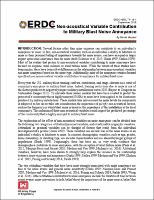Please use this identifier to cite or link to this item:
https://hdl.handle.net/11681/29534| Title: | Non-acoustical variable contribution to military blast noise annoyance |
| Authors: | Wayant, Nicole M. |
| Keywords: | Noise Noise--Measurement |
| Publisher: | Geospatial Research Laboratory (U.S.) Engineer Research and Development Center (U.S.) |
| Series/Report no.: | Technical Note (Engineer Research and Development Center (U.S.)) ; no. ERDC/GRL TN-18-1 |
| Abstract: | Several factors other than noise exposure can contribute to an individual’s annoyance to noise. In fact, non-acoustical variables, such as an individual’s ability to habituate to noise or their personal feeling of importance towards the noise source, can have an equal or larger impact upon noise annoyance than the noise itself (Schomer et al. 2013; Guski 1999; Stallen 1999). Most of the studies that pertain to non-acoustical variables contributing to noise annoyance have focused on airplane, road, railroad, or wind turbine noise. While the results of these studies have been similar, there have been a few differences in the relationship between non-acoustical variables and noise annoyance based on the noise type. Additionally, none of the annoyance studies focused specifically on non-acoustical variable contribution to annoyance for military blast noise. Every year the U.S. military faces training curfews, restrictions, and range-closures as a result of community annoyance to military blast noise. Indeed, training restrictions due to noise is one of the factors predicted to negatively impact military installations out to 2025 (Report to Congress on Sustainable Ranges 2013). To alleviate these issues, models that have been created to predict the percent of a community that is highly annoyed (%HA) to noise have been applied to the blast noise produced by military installations. These models take into account the noise levels the community is subjected to, but do not take into consideration the importance of specific non-acoustical factors, such as the frequency in which blast noise is heard or the importance of the installation to the local community. The inclusion of these non-acoustical variables could impact the predicted percentage of the community that is highly annoyed to military blast noise. The exploration of the effect of non-acoustical variables on noise annoyance can be divided into the following two categories: attitudinal/personal variables, and situational/demographic variables. Attitudinal or personal variables can be thought of factors that result from the individual development of a person (Guski 1999). These variables can include fear of the noise source or an individual’s ability to habituate to noise. In contrast, demographic variables, such as age, gender, home ownership, or dwelling type, are societal characteristics and are shared by larger groups of populations (Guski 1999). Surprisingly, there has been no, or very weak evidence that demographics contribute to noise annoyance, with the exception of wind turbine noise (Peris et al. 2012; Marquis-Favre and Premat 2005; Miedma and Vos 1999; Michard et al. 2016). Attitudinal variables, however, have been shown to strongly help explain the variance in the relationship between noise exposure and annoyance (Guski 1999; Stallen 1999; Miedma and Vos 1999; Okokon et al. 2015; Pennig and Schady 2014; Fields 1993). The two attitudinal variables that have been most strongly associated with noise annoyance are fear of the noise source and general noise sensitivity (Guski 1999; Marquis-Favre and Premat 2005; Miedma and Vos 1999; Michard et al. 2016; Pennig and Schady 2014; Fields 1993; Wong et al. 2016). Other attitudinal contributors to noise annoyance include the duration of time between sound events, noise prevention beliefs, belief about the importance of the noise source, belief that authorities can control the noise, capability to cope with noise, and overall general thoughts towards noise (Stallen 1999; Fields 1993; Guski 1999;. Michard et al. 2016; Marquis-Favre and Premat 2005; Pennig and Schady2014). All of these non-acoustical variables depict an individual’s personal feelings towards noise. The goal of this paper is to use these non-acoustical variables, in addition to the blast noise to which a population is subjected, to predict the %HA. The use of %HA has been accepted across the world as a standard descriptor of a community’s response to noise (Schomer et al. 2013). In order to calculate this metric, the noise data must be binned into pre-determined decibel intervals. While necessary, the binning of noise data is not standardized and has the potential to misrepresent the relationship between noise and annoyance (Wayant and Nykaza 2017). There is, however, an alternative, do not bin the noise data (Wayant and Nykaza 2017; Taraldsen et al. 2016). Instead of %HA, the unbinned noise data can be used to determine the probability that a community will be highly annoyed. Using both binned and unbinned noise data, the goal is to determine if non-acoustical variables can significantly affect the calculation of community annoyance to military blast noise. Generalized linear models (GLzMs) will be used to calculate both %HA and probability of annoyance. The results will be judged based on different goodness of fit metrics. Lastly, a recommendation will be given for which non-acoustical variables should be used in a community noise annoyance to military blast model and whether or not noise data should be binned for such a computation. |
| Description: | Technical Note |
| Gov't Doc #: | ERDC/GRL TN-18-1 |
| Rights: | Approved for Public Release; Distribution is Unlimited |
| URI: | http://hdl.handle.net/11681/29534 http://dx.doi.org/10.21079/11681/29534 |
| Appears in Collections: | Technical Note |
Files in This Item:
| File | Description | Size | Format | |
|---|---|---|---|---|
| ERDC-GRL TN-18-1.pdf | 529.89 kB | Adobe PDF |  View/Open |